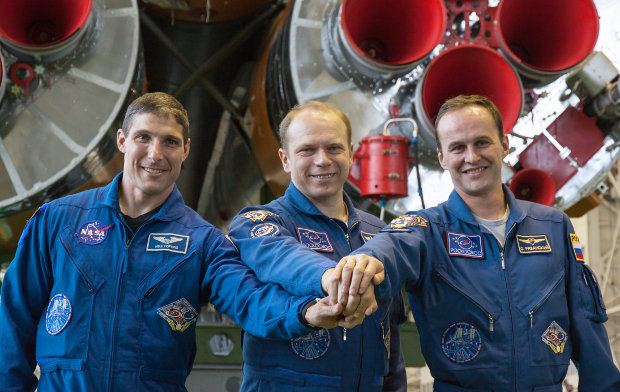
A few hours ago the Soyuz TMA-10M spacecraft was launched from the Baikonur Cosmodrome in Kazakhstan and after less than six hours reached the International Space Station with three new crew members on board. The Soyuz has used the fast trajectory successfully tested in the recent past.
The three new members of the crew of the International Space Station, who complete the crew of Expedition 37, are three flight engineers:
Michael S. Hopkins. Born on December 28, 1968 in Lebanon, Missouri, USA, earned a bachelor of science in aerospace engineering from the University of Illinois at Urbana-Champaign in 1991 and a master of science in aerospace engineering at Stanford in 1992. Whe he was at the university he was a member of the Air Force Reserve Officer Training Corps and in the Air Force he became a flight test engineer. He also studied foreign languages and political science at the University of Parma in Italy. He currently holds the rank of colonel of the U.S. Air Force. He was selected by NASA in 2009 and is at his first experience in space.
Oleg Kotov. Born on October 27, 1965 in Simferopol, in the then USSR, he graduated from the Kirov Military Medical Academy. He joined the Russian space program in 1996 and over the years he attended various training courses for both the Mir space station and the International Space Station. He’s a veteran of space missions since he’s already been part of the crew station in 2007 with Expedition 15 and in 2010 with the Expedition 22/23, also serving as commander. He made two spacewalks.
Sergey Ryazansky. Born on November 13, 1974 in Moscow, in the then USSR, he graduated in biochemistry at the Moscow State University in 1996. After working as a researcher, in 2003 he was selected in the Russian space program. He participated in one of the tests of the Mars 500 mission that simulated a mission to Mars remaining in solitary confinement for 105 days with his “virtual crew”. This is his first space mission.
According to schedule, Hopkins, Kotov and Ryazanskiy will return to Earth in mid-March 2014. The new crew will take part in new medical investigations on the long-term effects of microgravity on the organism. The first task of the now complete Expedition 37, however, will be the management of the arrival of the Cygnus spacecraft. It was supposed to dock to the International Space Station last Sunday but a communication problem required sending a new version of the software by Orbital Sciences. It was therefore decided to proceed first with the arrival of new crew members, who are going to participate in the new Cygnus docking attempt, currently scheduled for Saturday September 28.
[ad name=”AmazonDocumentary”]


Permalink